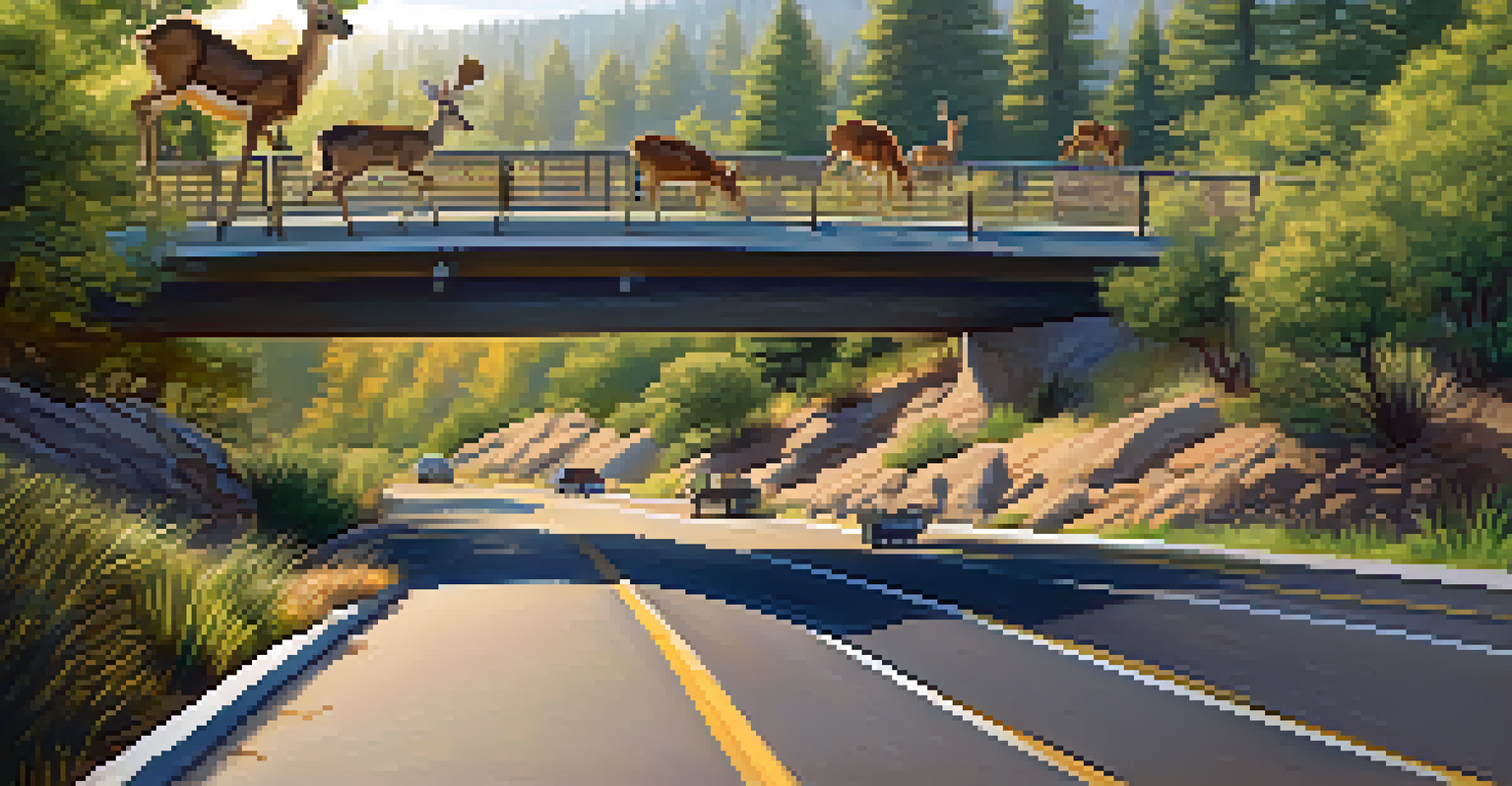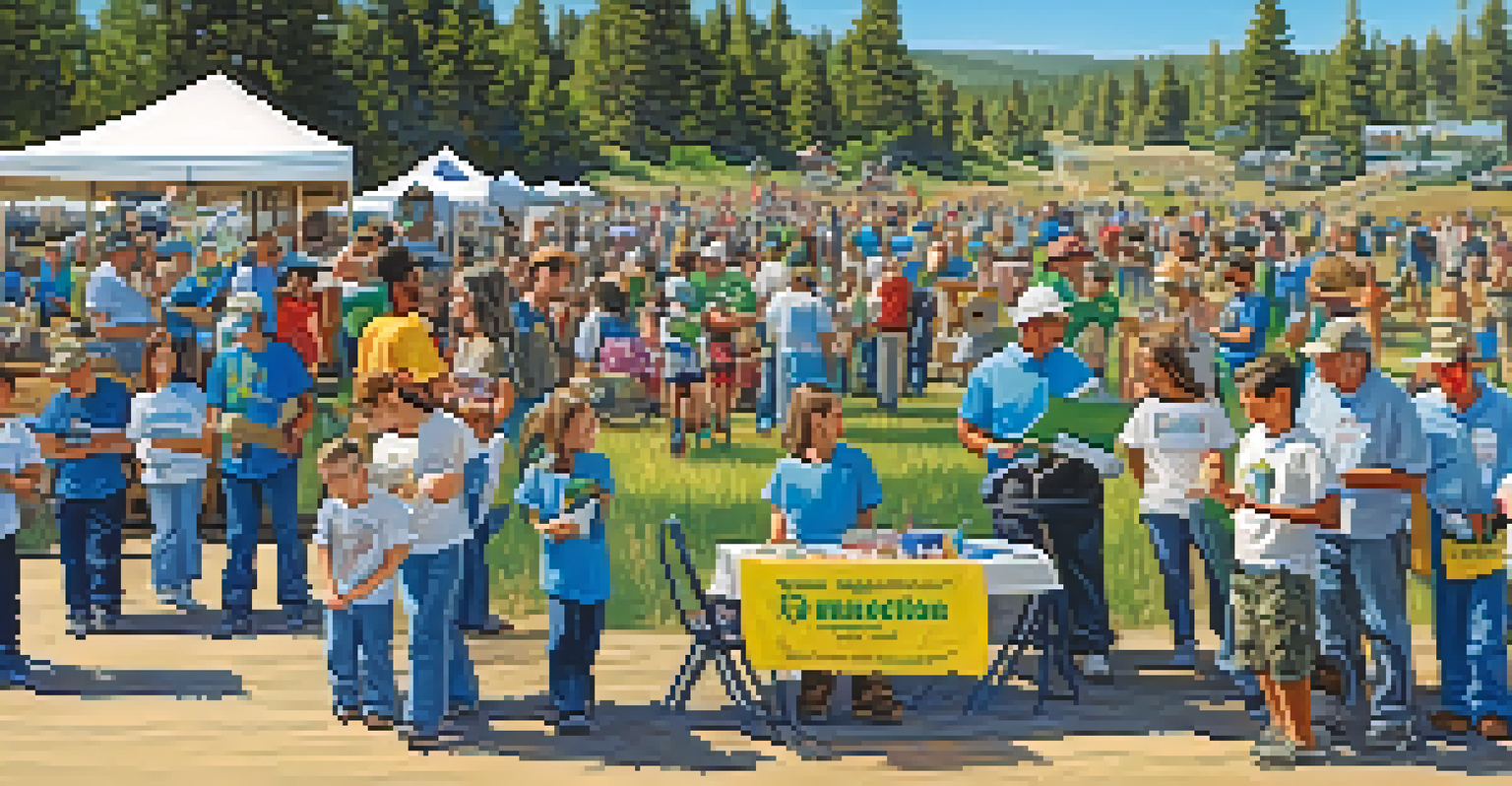Big Bear's Wildlife Corridors: Protecting Animal Migration Routes

Understanding Wildlife Corridors and Their Importance
Wildlife corridors are essential pathways that allow animals to migrate, find food, and reproduce. These routes help maintain genetic diversity within animal populations and ensure the health of ecosystems. In areas like Big Bear, these corridors become lifelines, connecting fragmented habitats that would otherwise isolate wildlife.
Wildlife corridors are vital for the survival of many species, allowing them to migrate, find food, and reproduce, which is essential for maintaining healthy ecosystems.
The significance of these corridors extends beyond the animals themselves; they also support the broader ecosystem. For instance, by allowing predators and prey to interact naturally, these corridors help regulate populations and maintain balance. This balance is crucial for preserving the intricate web of life that characterizes Big Bear.
Moreover, as urban development encroaches on natural habitats, the need for wildlife corridors becomes increasingly urgent. Protecting these pathways safeguards not just individual species, but the entire ecological health of the region. It’s a reminder of our responsibility to coexist with nature in a way that honors its complexity.
The Unique Wildlife of Big Bear Lake
Big Bear Lake is home to a diverse array of wildlife, from black bears and mountain lions to various bird species. Each of these animals plays a vital role in the ecosystem, contributing to its overall health and resilience. Understanding the unique needs of these species is crucial when discussing wildlife corridors.

For example, black bears require large territories to roam in search of food, while smaller animals like deer might need less space but still rely on safe passage to migrate. The design of wildlife corridors must take into account the specific needs of these animals to be effective. This tailored approach ensures that animals can move safely without the risk of collisions with vehicles or other hazards.
Community Engagement is Key
Local involvement in conservation efforts fosters awareness and action to protect wildlife corridors.
Additionally, the presence of diverse species enhances the overall biodiversity of the region, making it more robust against environmental changes. Each species has adapted to the unique climate and geography of Big Bear, which further emphasizes the necessity of protecting their migration routes.
Challenges Facing Wildlife Corridors in Big Bear
While wildlife corridors are vital, they face numerous challenges, primarily from human development. Roads, buildings, and other infrastructure can fragment habitats, making it difficult for animals to access critical resources. This fragmentation not only limits their movement but can also lead to increased mortality rates due to vehicle collisions.
The future of our planet hinges on our ability to protect the natural corridors that sustain wildlife and, by extension, ourselves.
Another challenge is climate change, which alters animal migration patterns and the availability of food and shelter. As temperatures rise and weather patterns shift, wildlife must adapt quickly, often relying on established corridors to navigate these changes. If these routes are obstructed, it could have dire consequences for their survival.
Additionally, public awareness and support for wildlife corridors are crucial. Many people may not realize the importance of these pathways or how their daily activities impact local wildlife. Education and outreach efforts can foster a sense of responsibility and encourage community action to protect these vital corridors.
Community Involvement in Wildlife Corridor Protection
Community involvement plays a pivotal role in the success of wildlife corridor initiatives. Local residents can participate in various conservation efforts, from volunteering for clean-up events to advocating for wildlife-friendly policies. Engaging the community helps build a collective understanding of the importance of these corridors.
Moreover, local organizations often host educational programs to raise awareness about wildlife migration and the threats they face. Such initiatives can inspire individuals to take action, whether by supporting conservation groups or making lifestyle changes that minimize their environmental impact. This grassroots effort is vital for fostering a culture of conservation.
Wildlife Corridors Are Essential
These pathways allow animals to migrate, find food, and maintain genetic diversity, crucial for ecosystem health.
Successful examples of community engagement can be seen across the country, where citizens have banded together to create protected areas and advocate for wildlife-friendly infrastructure. In Big Bear, similar initiatives could enhance the effectiveness of wildlife corridors and ensure that future generations enjoy the region's natural beauty.
Innovative Solutions for Wildlife Corridor Design
To effectively protect wildlife corridors, innovative solutions are being implemented worldwide. One approach involves creating overpasses and underpasses specifically designed for animal crossings. These structures allow wildlife to traverse busy roads safely, reducing the risk of accidents and ensuring their migration routes remain intact.
In addition to physical structures, technology plays a role in monitoring wildlife movement. GPS tracking and camera systems provide valuable data on animal behavior and migration patterns. This information helps conservationists make informed decisions about where to place corridors and how to enhance their effectiveness.
Furthermore, collaboration among various stakeholders—government agencies, conservation groups, and local communities—can lead to more comprehensive and effective corridor designs. By pooling resources and expertise, these groups can create a network of connected habitats that supports wildlife and preserves biodiversity in Big Bear.
The Role of Policy in Protecting Wildlife Corridors
Effective policies are essential for the protection and maintenance of wildlife corridors. Local governments can enact zoning laws and land-use regulations that prioritize the preservation of natural habitats and migration routes. These policies can ensure that development projects consider the needs of wildlife, reducing habitat fragmentation.
Moreover, funding for conservation programs can be allocated through policy initiatives. Public funds can support research, habitat restoration, and community education efforts. When wildlife corridors are recognized as a priority in policy discussions, it becomes easier to secure the resources needed to protect these vital pathways.
Policies Shape Corridor Protection
Effective local and federal policies are vital for preserving wildlife migration routes and supporting conservation initiatives.
On a larger scale, state and federal policies can provide additional support for wildlife corridor initiatives. By recognizing the importance of wildlife migration routes at higher levels of government, we can create a more cohesive approach to conservation that spans jurisdictions. This collective effort can enhance the effectiveness of local initiatives in Big Bear and beyond.
The Future of Wildlife Corridors in Big Bear
Looking ahead, the future of wildlife corridors in Big Bear depends on ongoing community engagement and adaptive management strategies. As environmental conditions continue to change, the designs of these corridors may also need to evolve. Flexibility and responsiveness to new challenges will be crucial for the long-term success of wildlife conservation efforts.
Additionally, fostering partnerships with research institutions and conservation organizations can enhance our understanding of wildlife needs. By studying animal behavior and environmental changes, we can develop more effective strategies for corridor design and management. This evidence-based approach will help ensure that these pathways remain viable for future generations.

Ultimately, the commitment to protecting wildlife corridors in Big Bear reflects a broader commitment to preserving the natural world. By prioritizing the health of our ecosystems and the animals that inhabit them, we pave the way for a sustainable future where both wildlife and humans can thrive together.